
guided coyote hunts
Guided coyote hunts offer thrilling experiences, combining skill and strategy. Experienced guides provide expertise, ensuring safety and success in pursuing these adaptable predators, known for their cunning nature.
1.1 What Are Guided Coyote Hunts?
Guided coyote hunts are organized hunting trips led by experienced professionals, offering participants a structured and strategic approach to coyote hunting. These hunts typically involve expert guides who possess deep knowledge of coyote behavior, habitats, and effective hunting techniques. Many guided hunts incorporate methods such as calling, decoy placement, and terrain navigation to increase success rates. Often conducted on private or public lands, these hunts cater to both novice and seasoned hunters, ensuring a safe and productive experience. Guides also handle logistics, including equipment setup and legal compliance, allowing hunters to focus on the pursuit. Coyote hunting is often pursued for population control, fur harvesting, or as a challenging and rewarding sport, making guided hunts a popular choice for those seeking a well-organized adventure.
1.2 Why Choose a Guided Hunt?
Choosing a guided coyote hunt offers numerous advantages, particularly for those new to predator hunting. Professional guides provide extensive knowledge of coyote behavior, habitat, and hunting strategies, significantly increasing the likelihood of success. They are familiar with prime locations and optimal times for hunting, ensuring participants make the most of their experience. Additionally, guides handle logistical challenges such as securing permits, setting up equipment, and navigating terrain, allowing hunters to focus on the hunt. Safety is a top priority, with guides trained in firearms safety and first aid. For experienced hunters, guided hunts offer access to exclusive areas and advanced techniques, enhancing their skills and overall hunting satisfaction. This combination of expertise, convenience, and safety makes guided coyote hunts a preferred choice for many enthusiasts.
Preparing for a Guided Coyote Hunt
Preparing for a guided coyote hunt is crucial. It involves physical conditioning, mental readiness, and understanding the hunt’s demands. Guides help ensure you’re fully prepared.
2.1 Physical Conditioning
Physical conditioning is essential for a guided coyote hunt. Hunters need to be in good shape to handle long hikes, cold weather, and the physical demands of the hunt;
Cardiovascular endurance, strength, and flexibility are key. Exercises like running, hiking, and weight training can help build stamina. Practicing with a loaded backpack simulates the hunt’s physical challenges.
Adequate nutrition and rest are also crucial. A well-prepared body ensures better performance and endurance during the hunt, making the experience safer and more enjoyable for participants.
2.2 Mental Preparation
Mental preparation is crucial for a successful guided coyote hunt. Hunters must develop focus, patience, and resilience to handle the challenges of the hunt. Visualization techniques can help build confidence and readiness. Understanding coyote behavior and anticipating scenarios mentally can improve decision-making during the hunt. Managing stress and staying calm under pressure are essential skills. Hunters should also cultivate adaptability, as weather and terrain conditions can change rapidly. A positive mindset and the ability to stay alert for extended periods are key to staying motivated and effective. Proper mental preparation enhances overall performance and ensures a safer, more enjoyable experience. Guides often provide strategies to help hunters mentally prepare, making the hunt more rewarding and successful.

Legal Aspects of Coyote Hunting
Understanding local laws, permits, and hunting regulations is essential. Ensure compliance with licensing requirements, season dates, and bag limits to avoid legal issues during guided hunts.
3.1 Licensing Requirements
Licensing is a critical legal aspect of guided coyote hunts. Hunters must obtain the appropriate state-issued license, which varies by region. Non-residents often require a different permit than residents. Ensure the license covers coyote hunting specifically, as some general hunting licenses may not include predators. Check with the local wildlife agency for deadlines and application processes. Youth and senior hunters may have discounted or specialized licenses. Guides may assist with paperwork, but ultimate responsibility lies with the hunter. Penalties for hunting without a valid license can be severe. Additionally, federal permits may be needed for certain hunting methods or baiting practices. Always carry the license during the hunt and follow export regulations if transporting harvested coyotes across state lines.
3.2 Seasonal Regulations
Seasonal regulations play a crucial role in guided coyote hunts, ensuring sustainable hunting practices. Coyote hunting seasons vary by state, with some allowing year-round hunting, while others restrict it to specific periods. Bag limits and possession limits are often enforced to manage populations. Certain methods, like night hunting or the use of dogs, may be restricted during specific seasons. Hunters must familiarize themselves with local regulations, as violations can lead to penalties. Guides often provide insights into seasonal rules, helping hunters stay compliant. Additionally, some states require reporting harvested coyotes to monitor population trends. Always verify the latest regulations before heading out, as they can change annually. Adhering to these rules ensures a safe and ethical hunting experience while supporting conservation efforts.
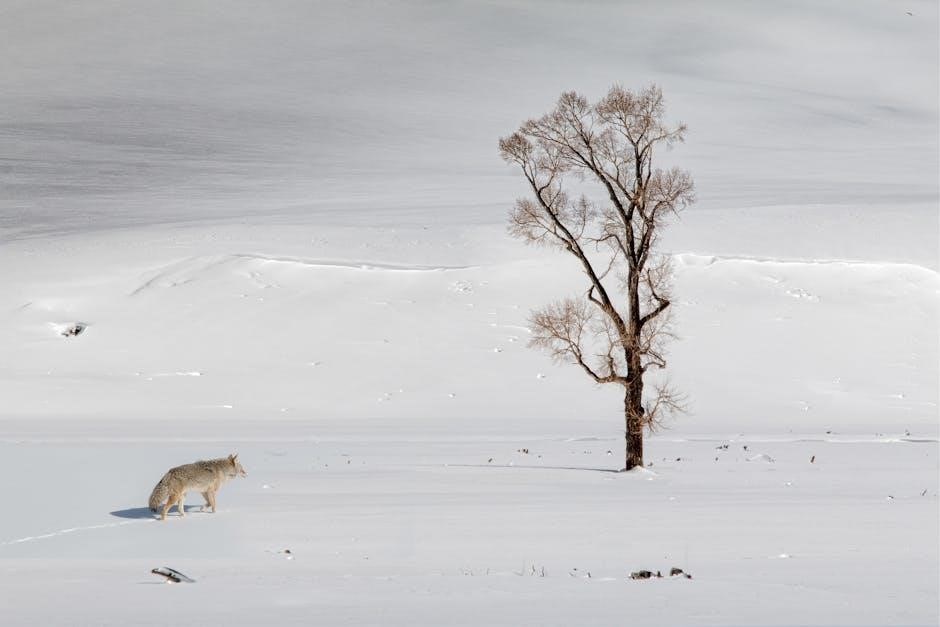
Effective Coyote Hunting Strategies
Effective coyote hunting strategies involve understanding coyote behavior, using proper calling techniques, and adapting to environmental conditions. Knowledge of their habitats and movement patterns is crucial for success.
4.1 Calling Techniques
Calling techniques are essential for attracting coyotes during guided hunts. Guides often use coyote howls, pup distress calls, or rabbit distress sounds to mimic prey. Electronic callers are popular for their versatility, allowing precise sound control. Hand calls, like mouth-blown options, offer a more traditional approach. The timing and realism of calls are critical; overly aggressive or unrealistic sounds can alarm coyotes. Guides typically start with soft calls to avoid spooking animals, gradually increasing intensity. Understanding coyote behavior helps in selecting the right call sequence. Effective calling strategies, combined with patience, significantly improve the chances of luring coyotes into range. Experienced guides know when to pause or change calls to maintain coyote interest, making this skill a cornerstone of successful hunts.

4.2 Using Decoys
Using decoys is a highly effective strategy in guided coyote hunts to lure animals into shooting range. Guides often employ realistic decoys, such as rabbit or coyote models, to mimic prey or other coyotes. These decoys are placed strategically in open areas, creating the illusion of movement and activity. Motorized decoys with adjustable speeds add realism, attracting coyotes from a distance; The placement and presentation of decoys depend on terrain and coyote behavior. Experienced guides know where to position them for maximum visibility. Decoys work best when paired with calling techniques, as they provide a visual target for curious coyotes. Proper decoy setup can significantly increase the chances of a successful hunt by drawing coyotes into ideal shooting positions.
Essential Gear for Coyote Hunting
Binoculars, rangefinders, and sturdy footwear are crucial for navigating terrain. Gear like decoys, calls, and scent attractants enhance hunting success. A reliable backpack ensures all essentials are within reach.
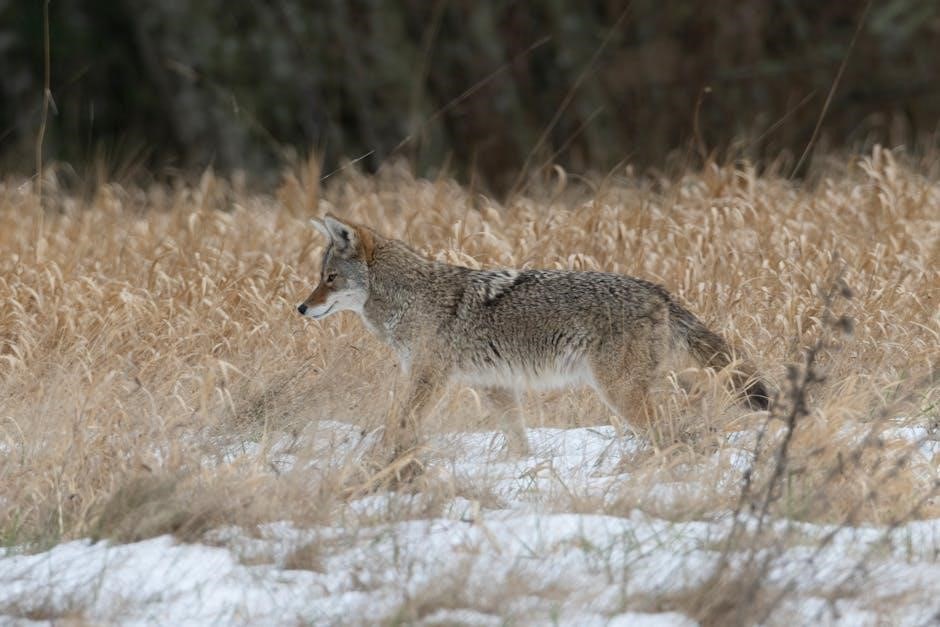
5.1 Rifles and Optics
A high-quality rifle chambered in .223 Remington or .243 Winchester is ideal for coyote hunting due to their effective range and manageable recoil. Opt for a durable, lightweight rifle with a reliable action. Pair it with a versatile scope, such as a 3-9x40mm, offering clarity and adjustable magnification for varying distances; Red dot sights are excellent for close-range shots but lack the precision of scopes for longer engagements. Ensure your optics are fog-proof and rugged to withstand harsh field conditions. A bipod or shooting stick enhances stability, while a suppressor can reduce noise and recoil. Always zero your rifle before the hunt and practice shooting from different positions to build confidence and accuracy. Properly maintained gear ensures reliability in the field, making it essential to inspect and clean your equipment regularly.
5.2 Camouflage and Clothing
Camouflage and appropriate clothing are crucial for a successful guided coyote hunt. Choose patterns like Realtree or Mossy Oak that blend with natural surroundings. Earth-tone colors help hunters remain undetected. Layering is essential: a breathable base layer, insulating mid-layer, and waterproof outer shell. This system adapts to changing weather conditions. A facemask and gloves hide skin tones, while a hat shields the face and head. Sturdy, waterproof boots with good traction are vital for navigating rough terrain. Avoid bright colors or reflective items that might spook coyotes. Scent-control clothing or sprays can minimize human odor, increasing the chances of getting close to your target. Dressing appropriately ensures comfort and stealth, key factors in a successful hunt. Proper attire enhances your ability to blend in and move quietly, making it easier to approach coyotes effectively. Always prioritize practicality and concealment when selecting hunting gear.
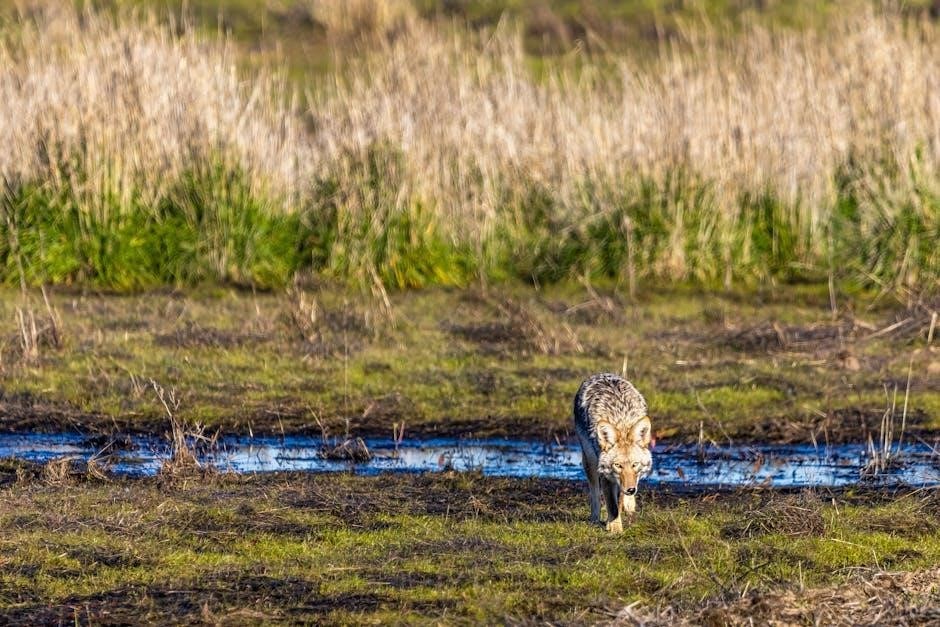
Role of Guides in Coyote Hunts
Experienced guides provide invaluable expertise, ensuring hunters locate coyotes, navigate terrain, and adhere to safety protocols, enhancing the overall success and enjoyment of the hunt.
6.1 Experience and Knowledge
Guides bring extensive experience and in-depth knowledge of coyote behavior, habitats, and patterns. Their expertise helps hunters identify tracks, signs, and vocalizations, ensuring better chances of success. Seasoned guides understand how coyotes adapt to seasonal changes and human activity, allowing them to strategize effectively. They are skilled in tracking and calling techniques, which are crucial for luring coyotes. Their familiarity with prime hunting locations and timing maximizes opportunities. Additionally, guides possess local insights into terrain, weather, and legal requirements, ensuring a seamless and productive hunt. Their knowledge enhances both the safety and efficiency of the expedition, making them indispensable for both novice and experienced hunters.
6.2 Safety and Success Rates
Guided coyote hunts prioritize safety, with experienced guides ensuring a secure environment for all participants. Their expertise minimizes risks associated with navigating challenging terrains and handling firearms. Guides are trained in emergency response and first aid, providing an added layer of protection. They also contribute significantly to high success rates by leveraging their knowledge of coyote behavior and habitats. Their ability to read signs, track effectively, and employ proven strategies enhances the likelihood of a successful hunt. With a focus on ethical practices, guides ensure that hunts are conducted responsibly, balancing safety with effectiveness. Their involvement not only improves outcomes but also fosters a positive and educational hunting experience for participants.
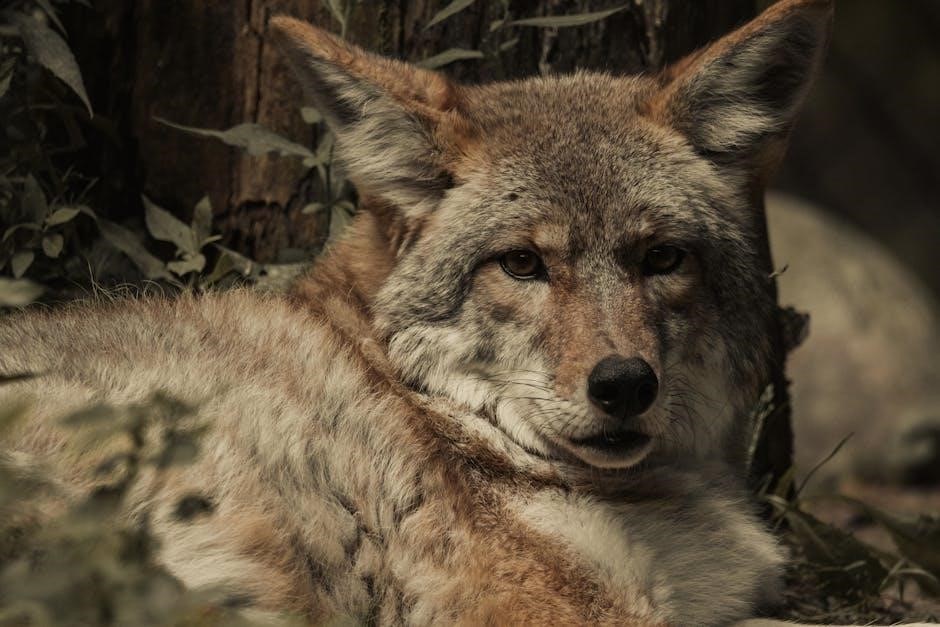
Best Locations for Guided Coyote Hunts
Prime locations include regions with high coyote populations, such as Texas, Wyoming, Montana, and the Dakotas, offering vast open spaces ideal for guided hunts.
7.1 Prime Regions in the US
The United States offers numerous prime regions for guided coyote hunts, with Texas, Wyoming, Montana, and the Dakotas being top destinations. These areas boast abundant coyote populations and vast, accessible terrains. Texas provides diverse landscapes, from deserts to rolling plains, while Wyoming and Montana offer expansive wilderness areas ideal for tracking. The Dakotas, particularly South Dakota, are renowned for their high coyote densities and experienced guides. These regions attract hunters due to their rich wildlife and favorable hunting conditions. Guides in these areas often have deep local knowledge, ensuring a productive and memorable experience. Whether you prefer open fields or rugged terrain, these prime regions cater to various hunting styles and preferences, making them hotspots for coyote hunting enthusiasts nationwide.
7.2 Habitat and Terrain
Coyotes thrive in diverse habitats, making guided hunts adaptable to various terrains. Open grasslands, dense forests, deserts, and agricultural areas are common coyote habitats. Guides often select locations with ample cover, such as brushlands or rocky outcrops, where coyotes tend to roam. The terrain can significantly impact hunting strategies, as open areas may require long-range shooting, while dense regions demand stealth and precision. Elevated positions, like ridges or hills, are often used to spot coyotes moving in the distance. The ability to navigate and interpret the landscape is crucial for success. Guides with local expertise can pinpoint areas where coyotes are most active, ensuring hunters are well-positioned regardless of the terrain. Understanding the interplay between habitat and coyote behavior is key to a productive hunt.
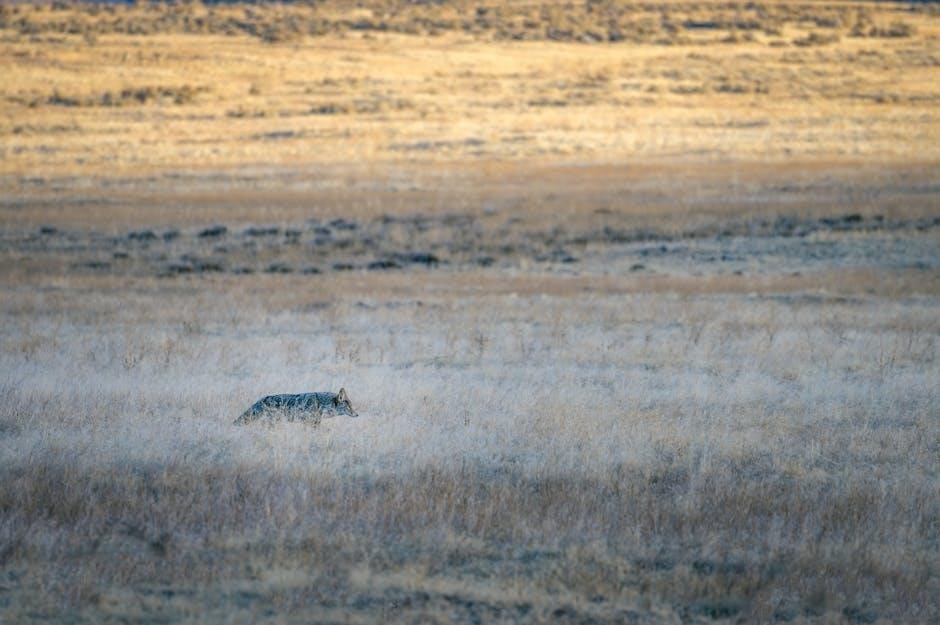
Safety Measures in Coyote Hunting
Safety is paramount in coyote hunting, involving proper firearm handling, awareness of surroundings, and adherence to regulations to ensure a secure and ethical hunting experience.
8.1 Handling Firearms Safely
Safe firearm handling is critical during guided coyote hunts to prevent accidents and ensure a secure experience. Always treat firearms as loaded, keeping the muzzle pointed away from people and pets. Use trigger locks or safeties to prevent unintended discharges. Store firearms in cases when not in use, and never leave them unattended. Always wear eye and ear protection when shooting. Be aware of your surroundings, ensuring a clear backstop before firing. Properly maintain rifles to avoid malfunctions. Guides often provide firearm safety briefings, so listen carefully and follow their instructions. Adhering to these practices minimizes risks and promotes a safe hunting environment for everyone involved.
8.2 Navigating Terrain Safely
Navigating terrain safely is essential during guided coyote hunts, as the landscape can vary from dense forests to rocky plains. Always assess the terrain before moving, using GPS devices or maps to avoid getting lost. Wear sturdy footwear to handle uneven ground, and stay alert for hazards like steep slopes or unstable surfaces. Avoid overexertion in challenging terrains, as this can lead to injuries. Be cautious of weather conditions, such as icy or muddy surfaces, which can increase the risk of slips and falls. Guides often know the terrain well, so follow their advice to stay safe. Plan routes in advance and stick to designated paths when possible. Communication is key—let someone know your route and expected return time. This ensures help is available if needed, making the hunt both enjoyable and secure.
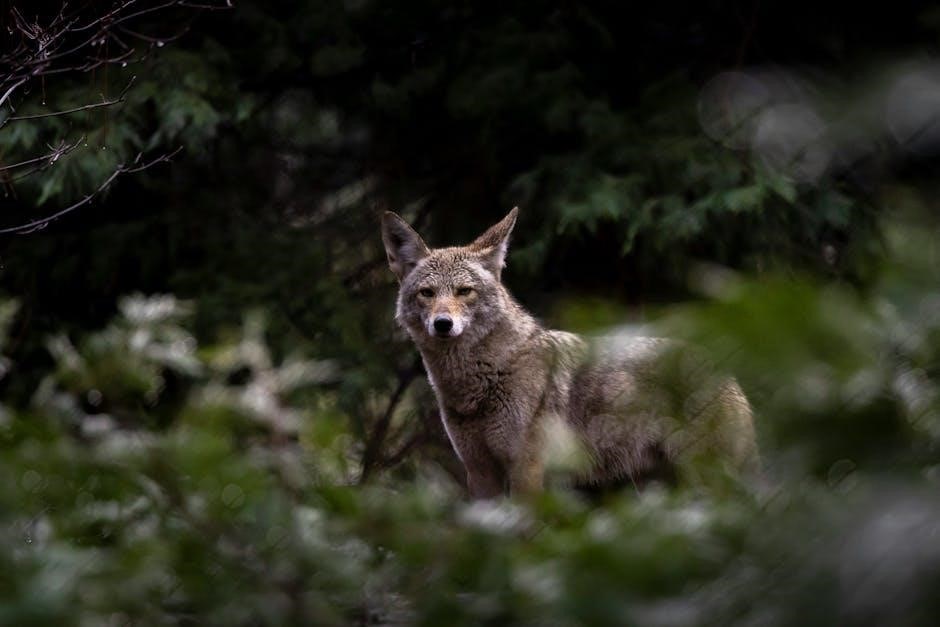
Ethical Considerations in Coyote Hunting
Ethical coyote hunting involves humane practices, minimizing suffering, and avoiding unnecessary kills. Hunters must respect the environment and ensure the hunt aligns with conservation goals and local laws.
9.1 Humane Practices
Humane practices in guided coyote hunts emphasize minimizing animal suffering and ensuring ethical treatment. Hunters should prioritize clean, quick kills to avoid prolonged distress. Guides often train participants to aim accurately and use appropriate firearms to guarantee instantaneous death. Non-lethal methods, such as calling and decoys, are favored to reduce unnecessary harm. Ethical hunters avoid practices like baiting or trapping, which can cause prolonged distress. Respect for the animal’s life and adherence to local regulations are crucial. Proper handling and disposal of carcasses further reflect a commitment to humane hunting. These practices not only uphold ethical standards but also promote a positive image of hunting within conservation efforts and public perception. Guides play a key role in enforcing these principles to ensure a responsible and respectful hunt.
9.2 Environmental Impact
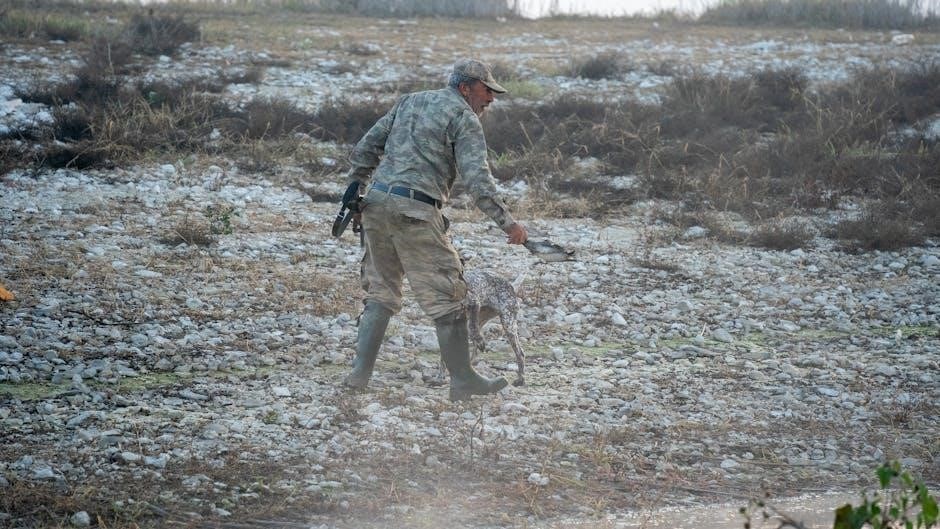
Guided coyote hunts can have both direct and indirect effects on the environment; Coyotes, as apex predators, play a crucial role in maintaining ecosystem balance by controlling prey populations, which can prevent overgrazing and protect vegetation. Responsible hunting practices, such as adhering to seasonal regulations and avoiding overhunting, help maintain stable coyote populations. Guides often emphasize minimizing habitat disturbance and avoiding practices that harm non-target species. Proper disposal of carcasses and respecting natural habitats are essential to preserving ecological integrity. Ethical hunting ensures that coyote hunting does not disrupt local food chains or cause unnecessary environmental degradation. By following sustainable practices, guided hunts can contribute to conservation efforts while managing coyote numbers effectively. This balance is key to maintaining healthy ecosystems and biodiversity.
Tips for a Successful Hunt
Research, preparation, and adaptability are key to success. Use proper gear, stay patient, and remain aware of surroundings. Follow guide instructions for optimal results and safety.
10.1 Understanding Coyote Behavior
Understanding coyote behavior is crucial for a successful hunt. Coyotes are highly intelligent and adaptable predators, often active at dawn, dusk, and night. They primarily hunt small prey but can also scavenge. Recognizing their tracks, scat, and vocalizations helps locate them. Coyotes are territorial and often travel in pairs or small family groups. They are cautious and have keen senses, making them challenging targets. Knowing their habitat preferences, such as open fields or brushy areas, aids in strategic planning. Seasonal behavior changes, like increased activity during mating or pup-rearing, can influence hunting success. Guides often study these patterns, helping hunters anticipate and respond effectively. This knowledge enhances hunting strategies and increases the likelihood of a successful outcome.
10.2 Adapting to Weather Conditions
Adapting to weather conditions is essential for a successful guided coyote hunt. Rain, snow, or extreme heat can alter coyote behavior and hunting strategies. In wet conditions, coyotes may be more active during daylight hours, while cold weather can push them to seek food more aggressively. Wind can impact calling effectiveness, requiring hunters to adjust their techniques. Guides often track weather patterns to predict coyote movement, ensuring hunters are positioned optimally. Proper gear, such as waterproof clothing or thermal layers, is crucial for comfort and performance. Understanding how weather influences coyote activity and adjusting strategies accordingly significantly improves hunting success. Guides play a key role in navigating these conditions, ensuring both safety and effectiveness.